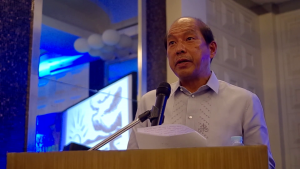
“The Administration’s larger vision to empower communities so they will no longer be passive beneficiaries, but will instead be co-implementers of government programs and projects.”
This was the statement given by Department of Budget and Management (DBM) head Florencio Abad during the second Asia Regional Conference on community-driven development (CDD), held last March 24-27, 2015 in Cebu City.
CDD is a development approach that puts power back in the hands of the people by giving them the voice and the vote to participate in the local development process and identify solutions that will address needs identified by communities themselves. Through CDD, citizens work hand-in-hand with government and non-government organizations to ensure that their needs are met and they become actively involved in local processes.
In the Philippines, the Kapit-Bisig Laban sa Kahirapan-Comprehensive and Integrated Delivery of Social Services (Kalahi-CIDSS) of the Department of Social Welfare and Development (DSWD) represents one of the biggest CDD programs in Asia and the Pacific, targeting 847 poor municipalities in the scaled-up program, which was approved last January 2013.
The conference, which had representatives from 14 CDD-implementing countries, served as a platform for the participants to examine the gains and challenges of implementing and mainstreaming the community-driven development strategy in different contexts, including conflict- and disaster-prone areas. The event was sponsored by the Asian Development Bank (ADB), the Australian Department of Foreign Affairs and Trade (DFAT), and the World Bank.
Empowerment, good governance, and transparency linked together
Secretary Abad, who opened the second day of the conference, discussed how CDD helps the government better address the needs of the people, especially the poor.
“When we involve citizens in governance – from the formulation of policies to ensuring that the Budget has impact on their lives – we are making the government more responsive to the needs of those in the grassroots,” he said.
He emphasized how empowering the citizens goes hand-in-hand with good governance, because it promotes transparency.
“In strengthening transparency, citizens can finally scrutinize government decisions and transactions,” he said. “This way, we’re giving our people, especially those in the margins, their rightful chance to not only to have voice but also vote in policymaking, and to subsequently take effective and meaningful action.”
“By strengthening public accountability mechanisms, we can deter abuses by those in positions of authority, besides ensuring that their actions and investments lead to more jobs and growth opportunities for the ordinary Filipino,” he continued.
Participation of LGUs
Secretary Abad also pointed out the important role of local government units (LGUs) in mobilizing citizens to become involved in the development process, emphasizing the importance of strategic devolution and local autonomy in developing the grassroots.
“Our LGUs are in the best position to know the needs of their constituencies, and they have the access to community perspectives that the central government does not,” he said.
“Even if we reform national government agencies and improve their ability to deliver services, we can only expand their absorptive capacity to a limited extent,” he continued. “If we are going to pursue sustainable solutions for our communities, we have to optimize the role of local governments and make viable arrangements so we can download more funds and responsibilities to them.”
Bottom-up budgeting and Kalahi-CIDSS
The devolution of responsibilities is one of the reasons for the bottom-up budgeting (BUB) initiative, a strategy of the Philippine government for the citizens, particularly the poor, to be able to participate in the local budgeting process to ensure that programs and services are responsive to their needs.
Secretary Abad said, “Bottom-Up Budgeting opens up a space within which government and citizens can interact meaningfully.”
He also discussed how BUB was developed partly because of the gains generated through the Kalahi-CIDSS, because the program showed the significance of community-level participation in local development planning, budgeting, and governance.
Aside from using Kalahi-CIDSS as one of the bases for the development of the BUB, Secretary Abad also said that the government is in the process of merging its processes with the CDD program. Part of this is the inclusion of Kalahi-CIDSS community volunteers in the local poverty reduction action teams (LPRAT).
The LPRAT is tasked with developing the Local Poverty Reduction Action Plan (LPRAP), in which the programs and projects that address the needs of the poor in the municipality are outlined. It is composed of representatives from the LGU, national government agencies, and civil society organizations.
Aside from the inclusion of Kalahi-CIDSS volunteers in the LPRAP in the 2016 BUB implementation, BUB funds can be used to support the implementation of CDD projects of Kalahi-CIDSS.
In an earlier session during the conference, Secretary Corazon Juliano-Soliman of DSWD said, “With Kalahi-CIDSS and BUB, the space is opened up and expanded for the political participation of underserved communities. It is a process of leveling the playing field and providing equitable access to resources and opportunities, especially to those once belonged in the margins.”###


